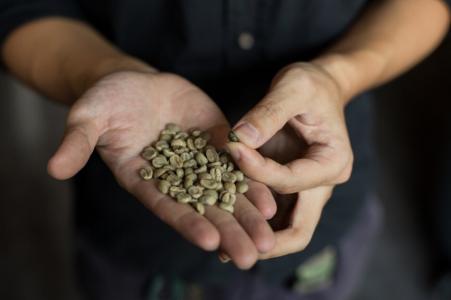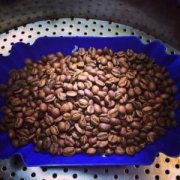A brief introduction to the treatment method of grinding degree and baking degree of red top coffee iron card fine coffee beans

Iron pickup, also known as the old variety of small-grain coffee, its yield is less, cultivation is difficult, so the price is much higher than ordinary small-grain coffee. Tibica coffee, native to Ethiopia and southeastern Sudan, is the most widely cultivated variety of coffee in the Western Hemisphere. The plant is stronger, but not light-tolerant, and the yield is higher in Hawaii. The top leaf of Tibika is red and copper, which is called red top coffee.
Typica Tibica (Tibica): the oldest native variety in Ethiopia, all Arabica are derived from Tibica. It belongs to the ancient coffee with elegant flavor, but its physique is weak, its disease resistance is poor and it is easy to catch rust leaf disease, and its fruit yield is also low, which is not in line with economic benefits. In recent years, Tibika has been gradually replaced by Kaddura and Kaduai in Central and South America, which is becoming more and more rare. Although Tibica has a good flavor, it is not nearly as popular as bourbon. One of the features is that Tibika's parietal leaves are bronzed. Mantenin, Blue Mountain, Elephant Bean, Kona, Yunnan Xiaodou, Rosa, and so on, are all derived varieties of Tibika. Tibica's beans are larger, pointed, oval or thin, different from Bourbon's round beans.
Coffee is a short-day plant. Coffee has the characteristics of multiple flowering and concentrated florescence. The florescence of small seed coffee in Yunnan is from February to July, and the flowering period is from March to May. The flowering of coffee is greatly affected by climate, especially rainfall and temperature. Coffee flowers have a short life span of only 2-3 days. Small seed coffee usually opens at 3: 5 in the morning, and it takes a long time for the fruit to bloom from 5 to 7 in the morning. It takes 8 to 10 months for the fruit of small seed coffee to mature, usually from October to December of the year. Rainfall has a great influence on fruit development, and climatic conditions directly affect fruit development.
Walking into the village of Zhukula, a unique aroma of coffee came. It turns out that after a hundred years of edification, drinking coffee has long become a living habit of the local Yi villagers. Villager Qi Fenghua said that men and women, young and old, all like to drink coffee, grind themselves with iron pots and grind themselves. However, the coffee processing process is kept secret, no wife, no daughter.
After drinking the original, simple coffee, we approached what is known as the oldest coffee forest in China. At this time, the ancient coffee trees have produced clusters of coffee beans, although they will not mature until next month, but some of them will show bright red. Qi Fenghua said that this forest is considered to be the oldest ancient coffee forest in China. There are 1134 plants in 13 mu, 24 of which have a history of more than 100 years, which were introduced and planted by French missionaries when they built a church in Zhu Kula in 1892.
In 1892, French Catholic missionaries left such a legend. He entered the Zhukula missionary, built a local church and introduced the habit of drinking coffee to the village of Zhukula. He personally planted a coffee forest and taught local villagers to grow, drink and sell coffee. From then on, the local villagers began to grow, grind and drink their own coffee, which continues to this day.
Li Fusheng, an 86-year-old villager from Zhu Kula village, said: "the coffee was planted by Father Tian for 117 years. I remember when there was a house high. There was a shed like this, and the roots were not as big as this."
Old man Li Fusheng is the first president of the village. The old man witnessed the history of coffee trees in Zhukula village. In 1948, President Li Fusheng launched the villagers to plant coffee on a large scale, which once grew to more than 80 mu, but a heavy snow in 1983 froze the coffee trees far away from the village to death. The 13 mu coffee trees around the village basically survived, with only 1134 left.
Ms. Huang Shuyun, a cultural scholar in Yunnan Province, said: "A Malaysian coffee expert once said that if you keep the old varieties of coffee in Yunnan, you will keep the status of Chinese coffee in the history of coffee in the world. Zhukula Coffee belongs to Yunnan small-grained Bobang Iron pickup Coffee, this kind of coffee is already very rare in Yunnan, so it is necessary for us to protect and develop it. "
In recent years, the local government is also fully aware of the importance of the protection and development of ancient coffee varieties in Yunnan, and regards coffee as a key industry for protection and development. The finance of Binchuan County allocates 100000 yuan of support funds every year to build the brand of "Zhu Kula century-old coffee". Yang Tiwu, director of the Economic Office of Pingchuan Town, is also resident in Zhukula Village to raise seedlings as a technician of seedling breeding of Zhukula Coffee. He said: "when we get to Zhukula Village, first, we should do a good job in the irrigation ditch (canal) of ancient coffee; second, we should control the diseases and insect pests of ancient coffee; and third, we should do a good job of pruning and interrupting to protect ancient coffee. On this basis, the next step is to do a good job in breeding. "
With the exception of Ethiopia, the origin of Arabica, the mutants or mixed-race varieties cultivated or found in Central and South America, India and East Africa are mainly Tibica and bourbon, and the genetic complexity is far lower than that of Ethiopia. this is the main reason for the weak physique and poor disease resistance of Arabica outside Ethiopia.
In addition, the biggest thing that bourbon and Tibica have in common is that shade trees must be "protected" to help block the sun. These two ancient varieties, such as unshaded trees, will not be conducive to growth and flavor development.
Common cultivated varieties of coffee, types of coffee beans:
Bourbon: juxtaposed with Tibica as an ancient and excellent variety. Some botanists even believe that Bourbon is a variant of the early Tibika transplanted to Yemen, where the bean shape changed from a thin tip to a round body. It was not until 1715 that France transplanted Mocha round beans from Yemen to the island of Bourbon on the east coast of Africa, and it was not until 1715 that it received the name round bourbon. Bourbon, which spread to Brazil and Central and South America in 1727, is also round beans. In addition, the British transplant of Yemeni mocha to St. Helena Island in 1732 was also a round bean. interestingly, it did not pass through Bourbon Island, but it was named Green Top Bourbon. It can be seen that the industry thinks that all the world's bourbon beans come from Bourbon Island is a big misunderstanding. It is important to recognize that there are many round bourbon beans that spread directly from Yemen without passing through the island of bourbon. In 181○, some of the round beans on Bourbon Island mutated into pointed beans, also known as "Bourbon pointed beans". Its caffeine content was only half that of ordinary coffee, and its output was low, weak, and extremely rare.
Important Notice :
前街咖啡 FrontStreet Coffee has moved to new addredd:
FrontStreet Coffee Address: 315,Donghua East Road,GuangZhou
Tel:020 38364473
- Prev

A brief introduction to the cultivation of slightly fruity tin tin card boutique coffee beans, geographical location, climate and altitude
Yunnan coffee was planted on a large scale in the mid-1950s, with a planting scale of 4000 hectares at one time. By the end of 1997, the planting area of coffee in the province had reached 7800 hectares. At present, the planting area of the province accounts for 70% of the national area, and the output accounts for 83% of the whole country. Yunnan coffee has established the dominant position in China in terms of planting area and coffee bean production. Yunnan coffee should be distinguished by planting.
- Next

A brief introduction to the Flavor and Flavor characteristics of the Fine Coffee Bean Flavor
Is it true that there is no G1 for washing Yega snow coffee? Very rare G1 beans have to taste compared to the traditional sun-treated Harald producing area, sun exposure is not common, as the first water washing plant in Ethiopia is located. Coffee drinkers are more familiar with Yejia, which is famous for its elegant lemon and citrus style. The flavor of coffee treated with water washing is better than that of coffee.
Related
- Detailed explanation of Jadeite planting Land in Panamanian Jadeite Manor introduction to the grading system of Jadeite competitive bidding, Red bid, Green bid and Rose Summer
- Story of Coffee planting in Brenka region of Costa Rica Stonehenge Manor anaerobic heavy honey treatment of flavor mouth
- What's on the barrel of Blue Mountain Coffee beans?
- Can American coffee also pull flowers? How to use hot American style to pull out a good-looking pattern?
- Can you make a cold extract with coffee beans? What is the right proportion for cold-extracted coffee formula?
- Indonesian PWN Gold Mandrine Coffee Origin Features Flavor How to Chong? Mandolin coffee is American.
- A brief introduction to the flavor characteristics of Brazilian yellow bourbon coffee beans
- What is the effect of different water quality on the flavor of cold-extracted coffee? What kind of water is best for brewing coffee?
- Why do you think of Rose Summer whenever you mention Panamanian coffee?
- Introduction to the characteristics of authentic blue mountain coffee bean producing areas? What is the CIB Coffee Authority in Jamaica?

